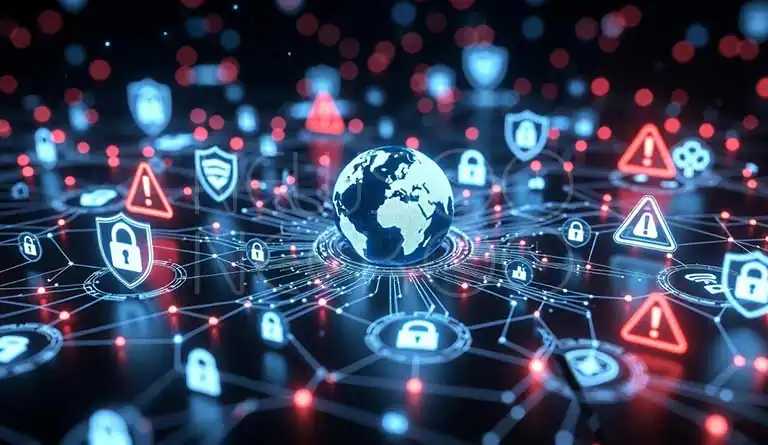Inside America’s Silent Cyber Crisis: How Trump’s Budget Cuts Are Leaving the Nation Exposed to Digital Threats
Almost a year into Donald Trump’s second administration, a quiet but dangerous crisis is unfolding behind the walls of Washington. While political debates dominate headlines, cybersecurity experts warn that deep federal budget cuts and the weakening of key agencies are leaving the United States increasingly vulnerable to cyber attacks just as threats powered by AI are exploding across the globe.
Experts say that this is not a theoretical risk. It’s happening in real time in hospitals, power grids, financial systems, and government databases. The very lines of communication that help America detect, respond to, and defend against cyber intrusions are being eroded.
A Nation Losing Its Digital Armor
A new assessment by the U.S. Cyberspace Solarium Commission– a bipartisan body created to strengthen the nation’s digital defense revealed troubling news: the U.S. has fallen behind on more than 80 cybersecurity goals that were once seen as vital to protecting national infrastructure.
Retired Admiral Mark Montgomery, who leads the commission, said he was “surprised and disappointed” by the results. “The reality is simple,” he explained. “Cuts to the Cybersecurity and Infrastructure Security Agency (CISA) and other departments are weakening our ability to defend ourselves at the exact moment when cyber threats are multiplying.”
The Commission’s report points to massive reductions at not only CISA but also across the State Department, National Science Foundation, National Institute of Standards and Technology, and Department of Commerce. Together, these agencies form the foundation of America’s cyber defense network and experts fear their hollowing out could prove catastrophic.
Adding to the problem, a law that previously allowed companies to share cyber threat information without fear of legal or antitrust action expired in September. Without it, businesses may hesitate to share data about attacks, leaving federal agencies in the dark.
Washington Says “All Is Well” Experts Strongly Disagree
Despite the growing criticism, the Trump administration insists it’s committed to protecting the nation from cyber threats. In June, the White House issued an executive order that it said would “sustain and strengthen” cybersecurity efforts.
A CISA spokesperson defended the administration’s approach, saying the agency “continues to demonstrate daily collaboration and intelligence sharing” under the leadership of President Trump and Homeland Security Secretary Kristi Noem.
But Montgomery and other experts strongly disagree. “The administration’s self-assessment is far more optimistic than the situation warrants,” he said.
And recent events seem to support his concern. Just last week, the Congressional Budget Office was reportedly targeted by foreign hackers an attack that underscored how frequent and bold cyber incursions have become.
The Federal Retreat and Its Dangerous Ripple Effect
According to Carole House, former National Security Council advisor, the government’s retreat is forcing states and private industries to handle cybersecurity largely on their own without the funding or tools needed to do so.
“We’re shifting the responsibility for defending the nation’s digital infrastructure onto states and companies,” House said. “But at the same time, we’re cutting the resources they need to handle it. It’s like handing off the ladder while pulling it away.”
Another worrying rollback involves a rule that once held big tech companies accountable for developing secure software. That rule, experts say, has lost its enforcement power meaning there’s now less incentive for corporations to prioritize safety.
The result: Americans, their data, and the U.S. economy are more exposed to digital attacks than they were a year ago.
“Death by a Thousand Papercuts”
Admiral Montgomery described the situation as a “death by a thousand papercuts.” He pointed to the 2023 discovery of Volt Typhoon, a China-linked hacker group that quietly infiltrated U.S. critical infrastructure, including energy, water, and communication systems.
“When Volt Typhoon was uncovered, CISA issued steps to patch vulnerabilities,” Montgomery explained. “But not all companies acted. And since the communication networks between government and industry have weakened, it’s very likely more attacks are happening now and going undetected.”
The Trump administration also disbanded the Critical Infrastructure Partnership Advisory Council (CIPAC) — a key body that once enabled government agencies and private industries to share information about threats. Without CIPAC, experts say, many industries are operating in silos, trying to protect themselves with limited visibility into larger threats.
“The biggest setback is not technology,” said Evan Reiser, CEO of cybersecurity firm Abnormal AI. “It’s coordination. Data signals are trapped across different agencies and vendors. Without real-time sharing, defenders are fighting blind.”
You May Also Read: AI Boom vs Main Street: America’s Uneven Economy
The Rise of AI-Driven Cybercrime
While America’s digital defense system struggles, cybercriminals are getting smarter and faster with the help of artificial intelligence.
According to Kaitlin Betancourt, a cybersecurity attorney and AI governance expert, criminals are embedding AI into every part of their operations from analyzing victims to creating fake identities and even automating attacks.
“The risk level has gone up dramatically,” Betancourt said. “Cutting back on cybersecurity resources right now is like taking down your guard while your opponent grows stronger.”
Earlier this year, AI company Anthropic revealed that hackers used its chatbot, Claude, to run targeted psychological extortion schemes on 17 organizations, demanding ransoms between $75,000 and $500,000. While the attack was stopped, experts say it’s only a preview of what’s coming.
Must Read it: Baba Vanga Predictions Meets Donald Trump Policies
Policy Shifts That Weaken Enforcement
In June, Trump signed a new executive order that reshaped earlier cybersecurity rules set by Obama and Biden. The order retained some safety requirements but removed enforcement language particularly the part that allowed the Justice Department to penalize companies failing to secure their software.
Betancourt called this change “a quiet but significant weakening” of accountability. “Without strong enforcement, many firms will treat cybersecurity as optional, not essential,” she said.
Enemies Without Borders
Not all cyber threats come from ordinary criminals. Some attacks are carried out by nation-state actors hackers tied to countries like China, North Korea, or Iran. Their goals range from stealing money to disrupting the U.S. economy or military readiness.
In February, hackers linked to North Korea stole about $1.5 billion in cryptocurrency from Binance, with intelligence officials warning the money would likely fund weapons programs. These kinds of attacks, experts warn, could cripple global markets and national defense systems.
And while the U.S. also carries out cyber operations abroad, experts say the lack of strong domestic defenses makes America’s own systems dangerously exposed.
The Bottom Line: A Digital Reckoning Ahead
The weakening of America’s cybersecurity isn’t happening overnight it’s happening slowly, piece by piece. But experts fear that if the current trend continues, it could culminate in a national digital disaster.
As Montgomery puts it, “The systems that protect our power, our water, and our economy are interconnected. If one part breaks down, the rest can follow.”
The rise of AI-driven hacking means that cyber threats are no longer the work of lone hackers in dark rooms. They’re industrialized, automated, and often backed by foreign governments.
And yet, as federal resources shrink and coordination fades, the U.S. seems to be stepping backward in this global cyber war.
In the end, the story unfolding in Washington is not just about budgets or bureaucracy. It’s about whether the world’s most powerful nation can still protect its people and its future from the invisible wars of the digital age.
Author: Yasir Khan
Date: 07 Nov, 2025
For More Updates, Visit Newsneck













